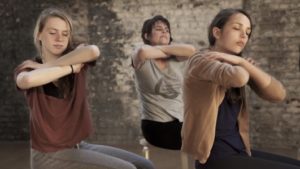 MINDFULNESS IN MOVEMENT
MINDFULNESS IN MOVEMENT
MOVE YOURSELF TO KNOW YOURSELF
The word “mindfulness” is everywhere these days. Frequently we associate mindfulness with a sitting meditation practice. As we sit and follow our breath we become more mindful, a term admittedly open to a variety of interpretations. A well known one suggested by Jon Kabat-Zinn is “paying attention in a particular way: on purpose, in the present moment, and non-judgmentally”. Sitting meditation is one way to promote mindfulness, but there are others. One of these is the Feldenkrais® Method.
South American Feldenkrais practitioner Lea Kaufman uses the phrase ”moverse para conocerse” (translation – move yourself to know yourself”) to explain what the Feldenkrais and by extension the Anat Baniel methods are about. What I love about this, aside from the fact that in Spanish it seems very poetic, is that it captures the totality of the Feldenkrais experience.
As was highlighted in a recent New York Times article by Jane Brody, a large percentage of the people who come to Feldenkrais do so because they are experiencing some sort of pain or physical limitation. The two can be intertwined. In Feldenkrais students/clients explore either through easy non-habitual active movement or gentle hands on work what it would be like to move with optimal ease and efficiency, often leading to deceases in pain and improvements in performance of some sort of physical skill.
In this particular situation I would say mindfulness in movement is to begin to recognize unnecessary tensions and inefficient movement habits that are getting in your way.
However, there are folks who come to Feldenkrais for reasons other than physical challenges. Moshe Feldenkrais never intended his work to be physical therapy. He saw it as a way to optimize human potential in whatever way appropriate to an individual. I clearly remember one of my Feldenkrais trainers called this work the “ultimate mindfulness practice”. That of course is his judgment.
What I can say is that in Feldenkrais movement is used, either actively or gently performed by a practitioner, as a vehicle for awareness just as the breath is commonly used in meditation.
One is asked to pay attention to the feeling of the movement, either done actively or performed by a practitioner, in the present moment and without judgment.
If there were such a thing as a “mindfulness muscle”, I would say that both Feldenkrais and meditation are tools to strengthen it.
Just as meditators have many different answers as to what are the benefits of their practice, so do those who do Feldenkrais. Yes, for some it is related to physical pain, but other benefits include being more creative, thinking more clearly, being less reactive in conflict and feeling more physically spacious and open. Nearly all who do Feldenkrais find themselves able to move in a more whole body integrated easeful way, not something commonly associated with sitting meditation.
So circling back I could say that in its essence Feldenkrais provides a vehicle to get to know ourselves better – be it how we move in ways that keep us in pain or self-limiting thoughts or you can fill in the blank. Another Spanish phrase I will borrow from Lea is “re-conociendote a ti mismo” – getting to know yourself all over again – through movement.
Photo credit: © International Feldenkrais® Federation Archive, Robert Golden
